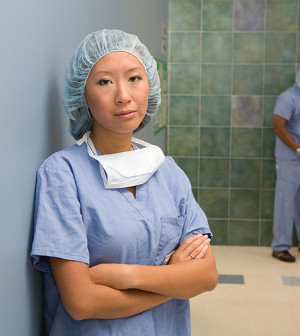- Navigating Your Midlife Crisis: Embracing New Possibilities
- City Raccoons Showing Signs of Domestication
- Mapping the Exposome: Science Broadens Focus to Environmental Disease Triggers
- One Week Less on Social Media Linked to Better Mental Health
- Your Brain Changes in Stages as You Age, Study Finds
- Some Suicide Victims Show No Typical Warning Signs, Study Finds
- ByHeart Formula Faces Lawsuits After Babies Sickened With Botulism
- Switch to Vegan Diet Could Cut Your Greenhouse Gas Emissions in Half
- Regular Bedtime Does Wonders for Blood Pressure
- Dining Alone Could Mean Worse Nutrition for Seniors
‘Good’ Bacteria Might Fight Common Hospital Infection: Study


Researchers may have found a new way to combat a stubborn and potentially deadly gut infection: a friendly version of the culprit bacteria itself.
The infection, caused by the bug Clostridium difficile, is a common scourge in hospitals. And experts say the findings, published May 5 in the Journal of the American Medical Association, are important.
Toxic strains of C. difficile bacteria cause diarrhea, abdominal cramps and, in some cases, severe inflammation of the colon.
The infection commonly strikes people during or after a hospital stay — usually those who’ve had a long course of antibiotics or have a weakened immune system.
C. difficile infections are at an all-time high in U.S. hospitals, said lead researcher Dr. Dale Gerding, a professor of medicine at Loyola University Chicago Stritch School of Medicine.
A recent U.S. government report said almost half a million Americans were sickened by C. difficile in 2011, and 29,000 died within a month.
Prolonged antibiotic use is often to blame because it can knock out “good” gut bacteria that would normally keep toxin-producing strains of C. difficile in check. Despite that, treatment with specific antibiotics, like vancomycin, usually beats back the infection at first.
Unfortunately, about 30 percent of patients fall ill again, Gerding noted.
“The antibiotics don’t completely get rid of the C. diff bacteria, and if the patient hasn’t developed an immune response against the toxin the bacteria produces, they’ll get sick again,” Gerding explained.
So, his team tried something new: After patients were successfully treated with an antibiotic, the researchers gave them a non-toxic strain of C. difficile — theorizing that the good bug would crowd out what remained of its toxic cousin.
And it appeared to work.
Of 125 patients who received the therapy, only 11 percent had a recurrent infection within six weeks. And a subgroup given a relatively higher dose of the good bug fared even better: Only two of 43 patients (5 percent) suffered another infection.
In contrast, 31 percent of patients given a placebo drug had a recurrent infection.
After treatment, Gerding said, the good C. difficile bugs “don’t stay around forever.”
Instead, he speculated, the therapy may set the stage for patients’ normal balance of gut bacteria to flourish again.
The findings are welcome news.
“This is a very important study because of the high recurrence rate of C. difficile infections, and because [recurrent] infections become progressively harder to treat,” said Dr. Lawrence Brandt, emeritus chief of gastroenterology at Montefiore Medical Center in New York City.
There is another treatment that works against recurrent C. difficile infections: fecal transplants. This involves giving patients an infusion of stool from a healthy donor, and doctors at Montefiore have used the approach for a decade, Brandt said.
The basic principle behind fecal transplants and the non-toxic C. difficile therapy is the same: restore a healthier bacterial balance in the gut.
“But this [new therapy] would, in theory, be safer and more reliable than a fecal transplant,” said Dr. Erik Dubberke, a spokesman for the Infectious Diseases Society of America.
With transplants, people receive a whole new microbial landscape, which could include something infectious, or have unanticipated long-term effects, Dubberke said.
“Plus,” he added, “the public seems to really like the concept of probiotics. And non-toxic C. diff would be about as targeted a probiotic as you could find.”
The findings are based on 173 patients with a C. difficile infection that was successfully treated with an antibiotic. They were randomly assigned to four groups: three that received different doses of non-toxic C. difficile, and one that was given a placebo.
The good C. difficile, Gerding said, is completely natural — with no genetic tweaking. Treatment involves drinking a colorless, odorless liquid once a day, for one week.
As for safety, patients on the therapy had headaches more often than the placebo group. But there was no evidence of serious risks, the researchers noted.
Larger studies are needed for the therapy to win approval, Dubberke said.
But the company that was developing the treatment and funded the current study — ViroPharma Inc. — was recently bought by another firm. So the future of the C. difficile therapy is up in the air, Dubberke and Gerding said.
More information
The U.S. Centers for Disease Control and Prevention has more on C. difficile infection.
Source: HealthDay
Copyright © 2025 HealthDay. All rights reserved.










